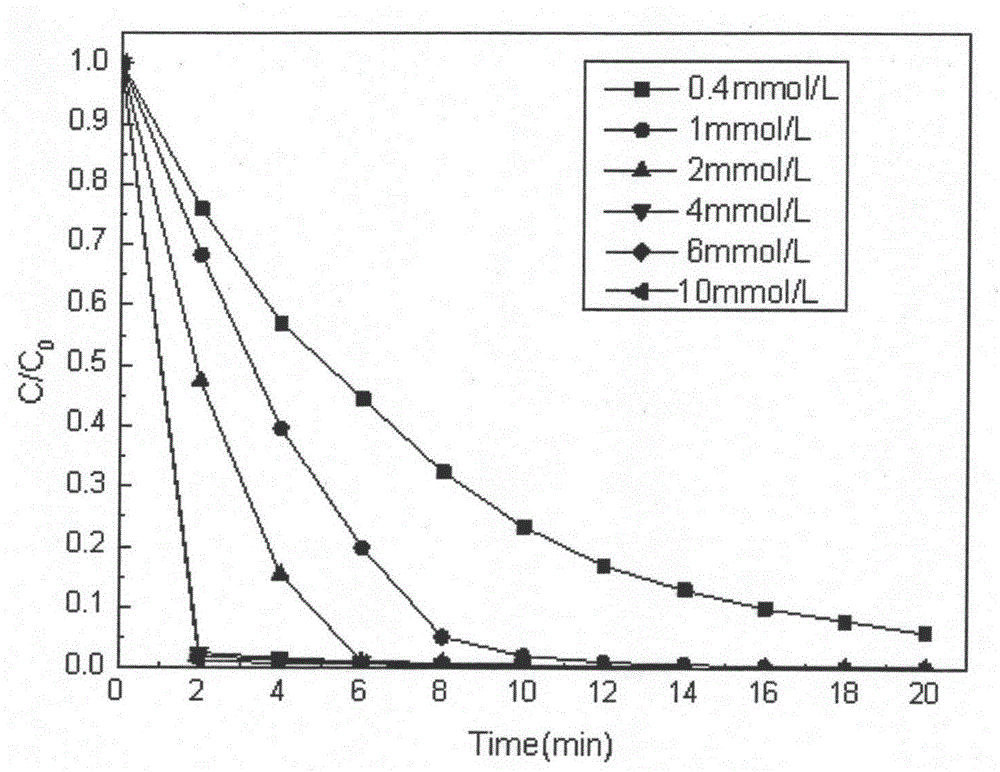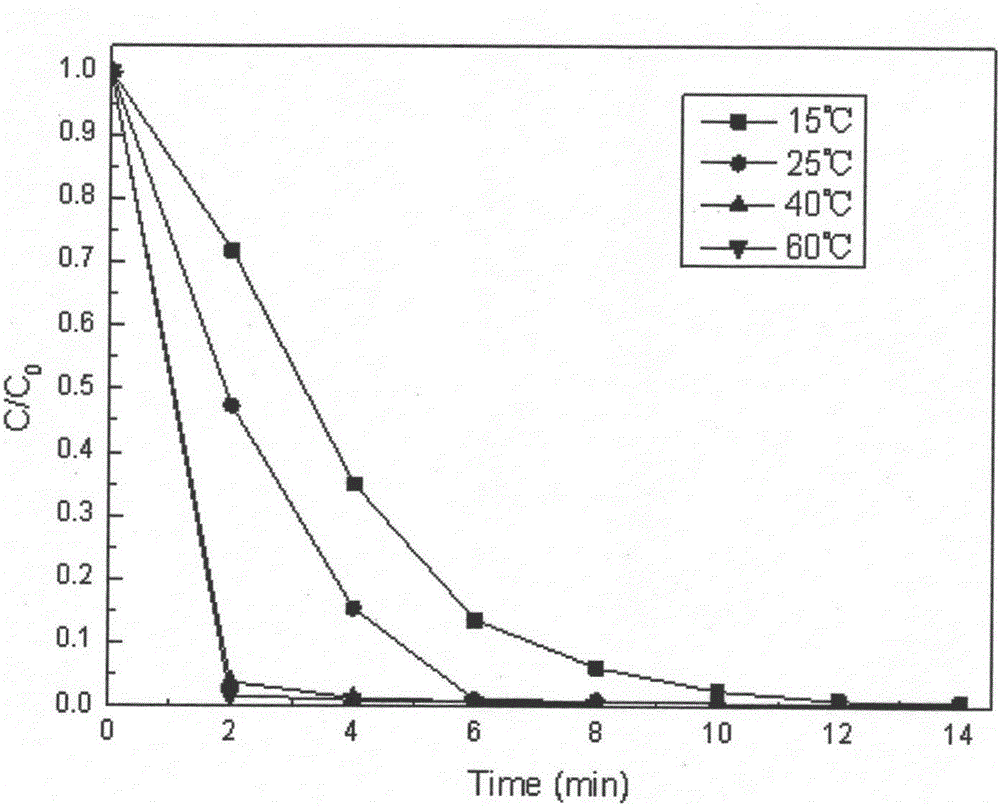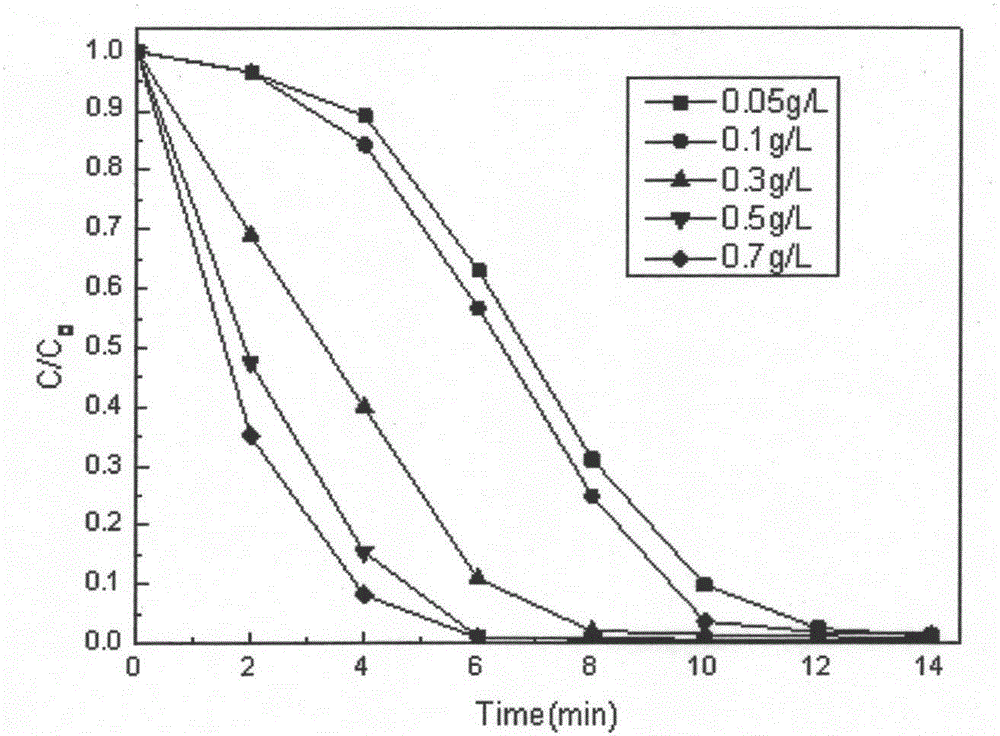Cellulose-based composite catalyst for catalyzing persulfate to degrade dye methyl orange and preparation method of cellulose-based composite catalyst
A composite catalyst, cellulose-based technology, applied in the field of composite materials, can solve the problems of reduced recycling and reuse activity, inconvenient recycling, easy decomposition of catalysts, etc., and achieves good reusability, wide application range and high mechanical strength. Effect
- Summary
- Abstract
- Description
- Claims
- Application Information
AI Technical Summary
Problems solved by technology
Method used
Image
Examples
Embodiment 1
[0030] Add 200 mg of graphite oxide powder into n-hexanol (120 mL), and form a uniformly dispersed suspension by ultrasonication for 2 h, and dissolve 1 mmol of cobalt nitrate hexahydrate (calculated as 0.291 g based on a relative molecular mass of 291.03) in another In n-hexanol (80 mL), a red solution was formed, mixed with the suspension containing graphite oxide, and stirred at room temperature for 0.5 h to mix the two substances uniformly. The mixture was then heated at reflux at 140 °C for 12 h. After the reaction, the reaction system was cooled to room temperature, centrifuged and washed (centrifuge speed test adjustment), and repeatedly washed with ethanol to remove n-hexanol and impurities therein, and finally the obtained product was dried in a vacuum oven at 60°C for use.
[0031] Sodium hydroxide, urea, and deionized water were configured into 100 g of a mixed solution at a mass ratio of 7:12:79, and 2 g of oxidized cellulose was added to it after cooling at -10°C ...
Embodiment 2
[0034] Add 100mL of prepared 0.2m·mol / L methyl orange solution into five reactors, add 0.4m·mol, 1m·mol, 2m·mol, 4m·mol, 6m·mol, 10m·mol mol of PMS, then use 0.5mol / L of NaHCO 3 Buffer solution to adjust the pH value of the solution to 7, add 0.05 g of the cellulose-based composite catalyst prepared in Example 1 to each conical flask, and place the conical flask on a constant temperature water bath shaker to adjust the temperature to 25°C. Oscillate at a constant temperature at a certain rate, and start timing, sample 5mL at regular time intervals, mix with an equal volume of quencher methanol solution to terminate the reaction, and then filter. Finally, UV-7504 spectrophotometer was used to measure the corresponding absorbance of the solution at 486nm. Each experiment was repeated three times to obtain the average value. Reaction result (C / C 0 represents the current concentration compared to the initial concentration) such as figure 1 As shown, it shows that the amount of...
Embodiment 3
[0036] All add 100mL prepared 0.2m·mol / L methyl orange solution in four reactors, according to the result of embodiment 2, each Erlenmeyer flask is all added the PMS of 2m·mol, then use 0.5mol / L L NaHCO 3 Buffer solution Adjust the pH value of the solution to 7, add 0.05 g of the cellulose-based composite catalyst prepared in Example 1 to each conical flask, and place the conical flasks on a constant temperature water bath shaker to adjust the temperature to 15°C , 25°C, 40°C, 60°C, shake at a constant temperature at a certain rate, and start timing, take 5mL samples at regular intervals, mix with an equal volume of quencher methanol solution to terminate the reaction, and then filter. Finally, UV-7504 spectrophotometer was used to measure the corresponding absorbance of the solution at 486nm. Each experiment was repeated three times to obtain the average value. Reaction result (C / C 0 represents the current concentration compared to the initial concentration) such as figu...
PUM
| Property | Measurement | Unit |
|---|---|---|
| clearance rate | aaaaa | aaaaa |
| quality score | aaaaa | aaaaa |
Abstract
Description
Claims
Application Information
 Login to View More
Login to View More - R&D
- Intellectual Property
- Life Sciences
- Materials
- Tech Scout
- Unparalleled Data Quality
- Higher Quality Content
- 60% Fewer Hallucinations
Browse by: Latest US Patents, China's latest patents, Technical Efficacy Thesaurus, Application Domain, Technology Topic, Popular Technical Reports.
© 2025 PatSnap. All rights reserved.Legal|Privacy policy|Modern Slavery Act Transparency Statement|Sitemap|About US| Contact US: help@patsnap.com



